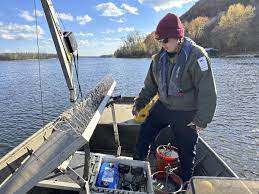
Wildlife officials across the Great Lakes are looking for spies to take on an almost impossible mission: stop the spread of invasive carp.
Over the last five years, agencies such as the U.S. Fish and Wildlife Service and Minnesota Department of Natural Resources have employed a new seek-and-destroy strategy that uses turncoat carp to lead them to the fish’s hotspot hideouts.
Agency workers turn carp into double agents by capturing them, implanting transmitters and tossing them back. Floating receivers send real-time notifications when a tagged carp swims past. Carp often clump in schools in the spring and fall. Armed with the traitor carp’s location, agency workers and commercial anglers can head to that spot, drop their nets and remove multiple fish from the ecosystem.
Kayla Stampfle, invasive carp field lead for the Minnesota DNR, said the goal is to monitor when carp start moving in the spring and use the tagged fish to ambush their brethren.;’
“We use these fish as a traitor fish and set the nets around this fish,” she said.
The carp are voracious eaters — adult bigheads and silvers can consume up to 40% of their bodyweight in a day — and easily out-compete native species, wreaking havoc on aquatic ecosystems. There is no hard estimates of invasive carp populations in the U.S. but they are believed to number in the millions.
State and federal agencies have spent a combined $607 million to stop the fish, according to figures The Associated Press compiled in 2020. Spending is expected to hit $1.5 billion over the next decade.
But wildlife and fisheries experts say it would be nearly impossible to eradicate invasive carp in the U.S. Just keeping them out of the Great Lakes and protecting the region’s $7 billion fishing industry would be a success.
Fisheries experts have employed a host of defenses, including electric barriers, walls of bubbles and herding the carp into nets using underwater speakers. But the fish still have made their way up the Mississippi as far as northern Wisconsin and grass carp have been found in Lake Erie, Lake Michigan and Lake Ontario, leaving fisheries managers racing to blunt the incursion.
Agencies such as the U.S. Fish and Wildlife Service and state wildlife managers have built a network of receivers extending from the St. Croix River in far northern Wisconsin to the Gulf of Mexico to record tagged invasive carp’s movement, with periodic data collection. The first receivers were deployed in the Illinois River in an effort to stem migration into Lake Michigan in the early 2000s.
Beginning around 2018, managers started placing new, solar-powered receivers around the Great Lakes region that could track tagged carp and send instant notifications to observers. The real-time notifications reveal where carp may be massing before a migration and illuminate movement patterns, allowing the agencies to plan round-up expeditions to remove carp from the environment and tag more traitor fish.
The receivers are essentially a raft supporting three solar panels and a locked box with a modem and a computer that records contacts with tagged carp. The receivers can pick up signals from tagged fish over a mile away, Fritts said.







